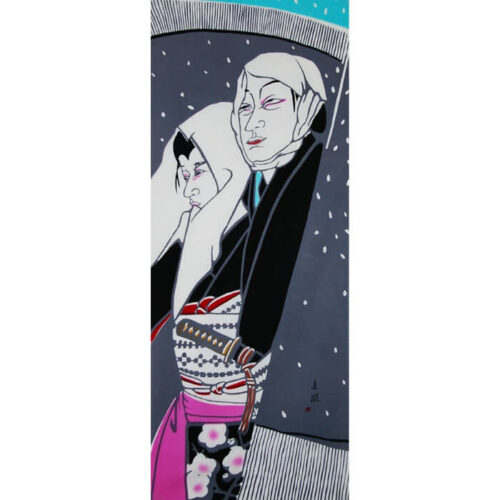
【KABUKI Miscellany】 Episode 9 : Narimono / Narrated by Tateo Okido
Hello! We are Asanoha, a tenugui specialty shop located in AzabuJuban, Tokyo.
We’re delighted to share a collection of intriguing stories related to Kabuki. These tales are narrated by Mr. Tateo Okido, an expert in Kabuki and the artist behind the original designs of our Kabuki-themed tenugui. Please enjoy this special series, Kabuki Miscellany, presented by Mr. Okido.
Kabuki Miscellany – Episode 9 : Narimono
In early kabuki illustrated scrolls such as Okuni Kabuki Sōshi, one can see figures playing the yokobue flute, drums, and taiko, and others singing while taking rhythm with fans. These were not simply performers dancing to a song—they were professional musicians.
Today, the term narimono in kabuki refers to all instruments other than the shamisen. In the early days of kabuki, there was no clear distinction between dance music and stage dialogue accompaniment—singers, shamisen, and narimono all appeared on stage together.
As the art evolved, dance accompaniment remained on stage while the music supporting dialogue and stage action was tucked away in a hidden space called the kuro‑misu. That ensemble of musicians and percussionists behind the scene is known in kabuki as geza.
Since the founding of kabuki, the exclusive music ensemble for long‑song (nagauta), shamisen, and hayashi percussion has been contained in this hidden space, performing supporting functions for both dance and drama.
This hidden musicians’ area is behind the black bamboo curtain (kuro‑misu), usually on stage left (from the audience’s view). In earlier times it stood stage right, but during the Bunka era it moved to stage left, becoming the modern location of the “down‑stage orchestra” (literally geza) area.
The instruments playing geza music fall into three categories:
1. Odori‑ji (short dance accompaniment)
2. Meriyasu (songs played when actors remain silent, heightening effect)
3. Kage (true orchestra accompaniment: scene change, entrances/exits, background, action cues)
The narimono belong to category 3 —those percussion instruments other than the shamisen. They create sound‑effects like thunder, rain, snow or hillside gusts with clever beats of drums and flutes. Snow, for example, though quiet in nature, is evoked in kabuki by the subtle rhythm “ton‑ton‑ton…” on a hand drum.
Actors themselves, from childhood, observe backstage mechanisms, props movement, and the workings of geza and narimono. What they absorb through that quiet education becomes part of their performance technique. In kabuki, actor movement alone cannot create the spectacle—narimono are a vital element of that theatrical world.

Tenugui “Ninokuchi-mura” – Original Artwork by Tateo Okido

